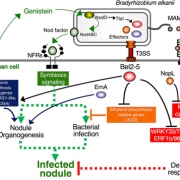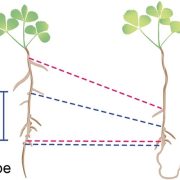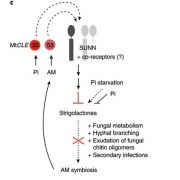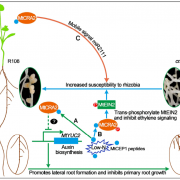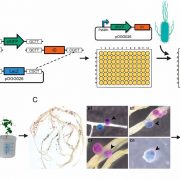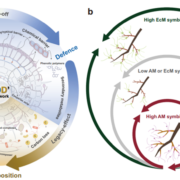Hydration source determines carbon asymmetry and physiological activities in lichen-forming symbionts
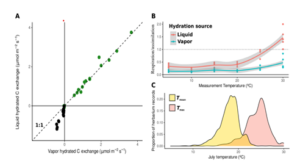 Metabolic activities in symbionts are often described as physiologically synchronized, but sometimes, as in the case of coral bleaching, this synchrony can break down. This breakdown was observed in lichen by Meyer et al. when they examined the physiologies of Evernia mesomorpha fungal and algal components during rehydration using either liquid water or water vapor. Lichen re-activation from desiccation and physiological activities of each symbiont were discovered to be affected by water hydration source. Hydration from water vapor re-activates algal components, and liquid water hydration favors the fungal components. This in turn causes an asymmetry in carbon balance between the lichen association, as carbon assimilation is entirely due to algal activity, whereas respiration is primarily due to the fungal partner. Gas exchange studies revealed the ability of algae associated with E. mesomorpha to achieve maximum carbon assimilation from water vapor hydration alone and transcriptomics analysis confirmed that physiologies of the primary lichen symbionts were decoupled from one another in response to hydration sources. Furthermore, the effect is exacerbated at higher temperatures, indicating that summer rains can contribute to lichen mortality. This asymmetry in carbon balance was also discovered to be common across other evolutionarily disparate lichen associations, highlighting the ecological importance of hydration source when predicting the impacts of climate change on lichens. (Summary by Idowu Arinola Obisesan, @IdowuAobisesan) Sci. Adv. 10.1126/sciadv.ado2783
Metabolic activities in symbionts are often described as physiologically synchronized, but sometimes, as in the case of coral bleaching, this synchrony can break down. This breakdown was observed in lichen by Meyer et al. when they examined the physiologies of Evernia mesomorpha fungal and algal components during rehydration using either liquid water or water vapor. Lichen re-activation from desiccation and physiological activities of each symbiont were discovered to be affected by water hydration source. Hydration from water vapor re-activates algal components, and liquid water hydration favors the fungal components. This in turn causes an asymmetry in carbon balance between the lichen association, as carbon assimilation is entirely due to algal activity, whereas respiration is primarily due to the fungal partner. Gas exchange studies revealed the ability of algae associated with E. mesomorpha to achieve maximum carbon assimilation from water vapor hydration alone and transcriptomics analysis confirmed that physiologies of the primary lichen symbionts were decoupled from one another in response to hydration sources. Furthermore, the effect is exacerbated at higher temperatures, indicating that summer rains can contribute to lichen mortality. This asymmetry in carbon balance was also discovered to be common across other evolutionarily disparate lichen associations, highlighting the ecological importance of hydration source when predicting the impacts of climate change on lichens. (Summary by Idowu Arinola Obisesan, @IdowuAobisesan) Sci. Adv. 10.1126/sciadv.ado2783


